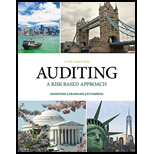
a)
Introduction:Brainstorming is a technique to create group activity through which efforts are made to find out a conclusion for a specified problem by collectingthe ideas given by its members.
To describe: The situation when brainstorming occur
b)
Introduction:Brainstorming is a technique to create group activity through which efforts are made to find out a conclusion for a specified problem by collecting the ideas given by its members.
To describe: The persons attending the brainstorming session and the leader of the session
c)
Introduction:Brainstorming is a technique to create group activity through which efforts are made to find out a conclusion for a specified problem by collecting the ideas given by its members.
To describe: Other purposes of brainstorming other than creative ideas for assessing audit risk.
d)
Introduction:Brainstorming is a technique to create group activity through which efforts are made to find out a conclusion for a specified problem by collecting the ideas given by its members.
To describe: The guidelines which help the team for maximizing the effectiveness of the brainstorming session.
e)
Introduction:Brainstorming is a technique to create group activity through which efforts are made to find out a conclusion for a specified problem by collecting the ideas given by its members.
To describe: The various steps involved of a brainstorming session.
Trending nowThis is a popular solution!

Chapter 7 Solutions
Auditing: A Risk Based-Approach (MindTap Course List)
- Please give me true answer this financial accounting questionarrow_forwardRaptors Inc. creates aluminum alloy parts for commercial aircraft. In a recent transaction Raptors leased a high precision lathe machine from Grizzlies Corp. on January 1, 2024. The following information pertains to the leased asset and the lease agreement: Cost of lathe to lessor $140,000 Grizzlies normal selling price for lathe 178,268 Useful life 7 years Estimated value at end of useful life 8,000 Lease provisions Lease term 5 years Payment frequency Annual Start date of lease January 1 Payment timing December 31 Estimated residual value at end of lease (unguaranteed) 20,000 Interest rate implicit in the lease (readily determinable by lessee) 7% Lessee's incremental borrowing rate 8% The lathe machine will revert back to the lessor at end of lease term, title does not transfer to lessee at any time, and there is not a bargain purchase option. Required…arrow_forwardFinancial Accountingarrow_forward
- Can you please solve this financial accounting problem without use Ai?arrow_forwardHobbiton Tours Ltd. has the following details related to its defined benefit pension plan as at December 31, 2024: Pension fund assets of $1,900,000 and actuarial obligation of $1,806,317. The actuarial obligation represents the present value of a single benefit payment of $3,200,000 that is due on December 31, 2030, discounted at an interest rate of 10%; i.e. $3,200,000 / 1.106 = $1,806,317. Funding during 2025 was $55,000. The actual value of pension fund assets at the end of 2025 was $2,171,000. As a result of the current services received from employees, the single payment due on December 31, 2030, had increased from $3,200,000 to $3,380,000. Required Compute the current service cost for 2025 and the amount of the accrued benefit obligation at December 31, 2025. Perform this computation for an interest rate of 8%. Derive the pension expense for 2025 under various assumptions about the expected return and discount rate. Complete the following table: Case…arrow_forwardCalculate Debt Ratios and Debt to Equity Ratio for 2016arrow_forward
- Please explain the correct approach for solving this financial accounting question.arrow_forwardIn 2026, Maple Leafs Co. sells its single machine, which cost $100,000 and has an undepreciated capital cost (UCC) of $25,000 for tax purposes. For financial reporting, the machine has carrying amount of $40,000. The sale price of the machine is $30,000. Aside from the sale of the machine, the company has other income (before taxes) of $600,000, which includes non-taxable dividends of $120,000 dollars received during the year. There are no other permanent or temporary differences. The company faces an income tax rate of 35%. Required Provide the journal entries for the company for 2026.arrow_forwardBlue Jays Corporation started operations on March 1, 2025. It needs to acquire a special piece of equipment for its manufacturing operations. It is evaluating two options as follows. Option 1: Lease the equipment for 5 years. Lease payments would be $11,000 per year, due at the beginning of each fiscal year (March 1). Blue Jays incremental borrowing rate is 5%. There is not a bargain purchase or renewal option. Blue Jays is responsible for all non-lease costs of operating the equipment. Option 2: Purchase the equipment for $50,000 by borrowing the full purchase amount at 5% over 5 years. This price is considered the fair value of the equipment. Payments are due at the end of each fiscal year (February 28). The equipment has a useful life of 5 years and would be depreciated on a straight-line basis. No residual value is expected to exist at the end of 5 years. Required Calculate the present value of the lease payments (Option 1). Calculate the payment that would be…arrow_forward
 Auditing: A Risk Based-Approach (MindTap Course L...AccountingISBN:9781337619455Author:Karla M Johnstone, Audrey A. Gramling, Larry E. RittenbergPublisher:Cengage Learning
Auditing: A Risk Based-Approach (MindTap Course L...AccountingISBN:9781337619455Author:Karla M Johnstone, Audrey A. Gramling, Larry E. RittenbergPublisher:Cengage Learning Auditing: A Risk Based-Approach to Conducting a Q...AccountingISBN:9781305080577Author:Karla M Johnstone, Audrey A. Gramling, Larry E. RittenbergPublisher:South-Western College PubBusiness/Professional Ethics Directors/Executives...AccountingISBN:9781337485913Author:BROOKSPublisher:Cengage
Auditing: A Risk Based-Approach to Conducting a Q...AccountingISBN:9781305080577Author:Karla M Johnstone, Audrey A. Gramling, Larry E. RittenbergPublisher:South-Western College PubBusiness/Professional Ethics Directors/Executives...AccountingISBN:9781337485913Author:BROOKSPublisher:Cengage EBK CONTEMPORARY FINANCIAL MANAGEMENTFinanceISBN:9781337514835Author:MOYERPublisher:CENGAGE LEARNING - CONSIGNMENT
EBK CONTEMPORARY FINANCIAL MANAGEMENTFinanceISBN:9781337514835Author:MOYERPublisher:CENGAGE LEARNING - CONSIGNMENT




